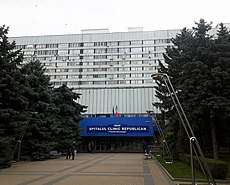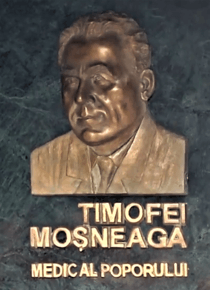Timofei Moșneaga Republican Clinical Hospital
The Timofei Moșneaga Republican Clinical Hospital (Romanian: Spitalul Clinic Republican „Timofei Moșneaga") is the oldest and largest medical institution in Moldova. It has 795 beds and 20 departments. It serves as the main clinical base for 15 departments and advanced courses of the Nicolae Testemițanu State University of Medicine and Pharmacy. It is named after former Health Minister and the hospital's longest-tenured director Timofei Moșneaga, who led the institution for over forty years.
| Timofei Moșneaga Republican Clinical Hospital | |
|---|---|
 | |

| |
| Geography | |
| Location | Nicolae Testemițanu 29 St., Chișinău, Moldova |
| Coordinates | 46°59′36.612″N 28°50′0.518″E |
| Organisation | |
| Type | General |
| Affiliated university | Nicolae Testemițanu State University of Medicine and Pharmacy |
| Services | |
| Emergency department | No |
| Beds | 795 |
| History | |
| Opened | 26 December 1817 |
| Links | |
| Website | www |
| Other links | www www |
History
Initially, the facility had the status of a municipal hospital. It was the first medical institution in Bessarabia and was built with the support of sponsors and citizens of Chisinau. The hospital opened on December 26, 1817. The first building had one and a half levels, housing five wards with 36 beds, where patients with therapeutic, surgical and gynecological problems were treated. The medical staff provided paramedicine services.
In 1842, another building was built. It had specialized units of therapy, surgery, ophthalmology and sexually transmissible diseases. In 1860, the staff consisted of one medical doctor (also the manager), a senior medical assistant, 3 junior medical assistants, 27 nurses, a linen mistress, a clerk, a copyist and a priest. A pharmacy operated on hospital premises.
In 1870, the institution was transferred to the Gubernskoe Zemstvo (the provincial government) and its name changed to Gubernial Hospital. The facility consisted of 100 beds, with a staff of 13 medical doctors and 40 medical assistants.
The need for medical staff, especially medical assistants and midwives, became more and more pressing. In 1872 the School of Medical Assistants and Midwives was founded. The first class of 17 students finished school in 1873 and remained to work at the hospital.
In 1876, special units for microscopy, morph-pathology and animal testing opened. In order to stop the spread of infectious diseases, a unit for vaccination against smallpox was formed. Over the years, the Gubernatorial Hospital was considered an important center for the education and continuous training of doctors from the cities and districts of Bessarabia.
The two World Wars gravely affected the activity of the Gubernial Hospital. Bombings left its buildings in ruins. It had to be rebuilt and reequipped. Its name became Republican Clinical Hospital. The institution eventually became the clinical base for the Chisinau Institute of Medicine.

In 1967, when the hospital was celebrating its 150th anniversary, it had 10 units for stationary treatment, a consulting polyclinic for the inhabitants of rural areas, an AVIASAN (sanitary aviation) department and numerous labs and diagnostic rooms, fitted with modern equipment. Units included anesthesiology, endocrinology, cardiothoracic and maxillofacial surgery. The artificial kidney unit opened there and was among the first in the Soviet Union. Clinical methods included laparoscopy, splenetic portography, phlebography, electro-chemiography and others. Extracorporeal dialysis and cardiac defibrillation were applied, new methods of anesthesia were added and the laboratory of nuclear medicine was created. In 1961, the first successful heart surgery took place. By 1966, 10,000 patients had received medical care. In 1977 the RCH moved to new premises. This facility permitted a significant rise in quality and efficiency and helped to improve and diversify the diagnostic methods and activity of labs and specialized units. Over 200 new diagnostics and treatments were implemented.
Staff

Between 1966–1996, 50 medical doctors were awarded PhDs in medicine, while 5 earned a M.D. degree. These specialists took part in international congresses, symposia and conferences.
During the first period of transition to a free market economy, the hospital faced a difficult situation, which improved with the 2004 implementation of medical insurance.
Operation
The hospital operates on the basis of a contract with the National Company for Medical Insurance (NCMI), which provides regular financing. The contract protects drug supply, provides modern medical equipment, new medical services and treatment methods.
Rural inhabitants represent more than 85% of the patients.
The Timofei Moșneaga Republican Clinical Hospital has 795 beds and 20 units, cared for by 1300 qualified specialists. It is the clinical base of 15 departments of the Nicolae Testemițanu State University of Medicine and Pharmacy and of its training program.
Directors
- Nicolae Testemițanu (1955 - 1958)
- Iulian Kaspersky (1958 - 1960)
- Timofei Moșneaga (1960 - 2003)
- Mihai Ouș (2003 - 2010)
- Andrei Usatîi (2010 - 2011)
- Anatol Ciubotaru (2015–2020)
External links
- Official website
- Official YouTube channel
- "Istoric :: IMSP Spitalul Clinic Republican "Timofei Moșneaga"". scr.md. Retrieved 2019-01-30.